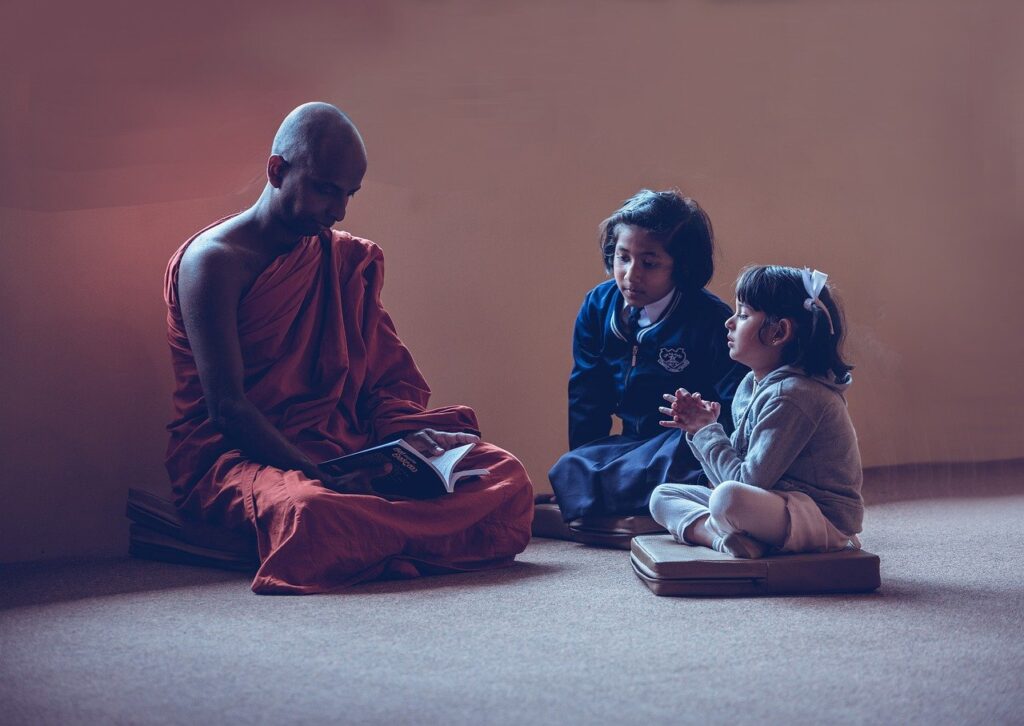Are you curious about how the concept of dharma, or duty/righteousness, is explained in the realm of yoga philosophy? Look no further! This article will delve into the fascinating world of yoga philosophy, providing you with a captivating and concise explanation of how the concept of dharma is understood within this ancient practice. So, grab your yoga mat and get ready to explore the profound connection between duty and righteousness in the realm of yoga.

Overview of Dharma
Definition of Dharma
In yoga philosophy, dharma refers to duty or righteousness. It is a foundational concept that guides individuals in leading a virtuous and purposeful life. Dharma encompasses the moral and ethical responsibilities one has towards oneself, others, and the universe as a whole. It is the inherent nature and purpose that governs all aspects of existence.
Importance of Dharma in Yoga
Dharma plays a vital role in yoga practice as it provides a framework for personal growth and spiritual development. By aligning with one’s dharma, individuals can establish harmony within themselves and with the world around them. It serves as a guide to make conscious choices and decisions that uplift and nurture the self, others, and the greater whole. Understanding and embodying dharma is essential for achieving the intended goals of yoga.
Historical Context of Dharma in Yoga
The concept of dharma has roots in ancient Indian philosophy and is deeply ingrained in the traditions of yoga. In the ancient texts, such as the Bhagavad Gita and the Yoga Sutras of Patanjali, dharma is extensively discussed and elucidated upon. It has been a guiding principle for individuals seeking deeper understanding of their place in the universe and the path to self-realization. Dharma has been integral to the lives of yogis and yoginis throughout history, shaping their actions, thoughts, and intentions.
Dharma in Yoga Philosophy
Connections between Dharma and Yoga
Dharma and yoga are intricately connected, sharing a symbiotic relationship. Yoga provides the means to attune oneself to dharma, while dharma acts as a guiding light on the yogic path. The practice of yoga cultivates self-awareness and inner harmony, enabling individuals to understand and fulfill their unique dharma. At the same time, living in alignment with dharma supports the journey towards oneness and self-realization, which are central goals of yoga.
The Role of Dharma in Achieving Yogic Goals
Dharma serves as a compass, directing practitioners in their pursuit of yogic goals. By adhering to their personal dharma, individuals can navigate the complexities of life and make choices that support their physical, mental, and spiritual well-being. Dharma acts as a guiding force, fueling the journey towards self-discovery, fulfillment, and liberation. Without the anchoring presence of dharma, the goals of yoga may remain elusive and the practice may lack depth and significance.
Interplay between Individual Dharma and Universal Dharma
While dharma can be understood as one’s personal duty, it is interconnected with universal dharma. Individual dharma aligns with the larger cosmic order and the dharma of all beings. It emphasizes the interdependence and interconnectedness of all life forms. By recognizing and honoring their unique dharma, individuals contribute to the collective harmony and well-being of the universe. Consequently, the realization of one’s individual dharma is intimately linked to the fulfillment of universal dharma.
Dharma as Duty
Understanding Dharma as One’s Personal Duty
Dharma, as duty, encompasses the responsibilities and obligations one has towards oneself, others, and society. It involves fulfilling roles and obligations with integrity, sincerity, and compassion. One’s personal duty may vary based on their stage of life, social position, and innate qualities. Embracing dharma as duty requires individuals to be mindful of their actions, thoughts, and speech, cultivating virtues such as honesty, kindness, and self-discipline.
Incorporating Dharma into Daily Life
Incorporating dharma into daily life is an ongoing practice that requires conscious effort and self-reflection. It involves aligning one’s actions, intentions, and attitudes with their personal dharma. This can be achieved by discerning right from wrong, embracing ethical principles, and acting in accordance with one’s inner values. By infusing dharma into every aspect of life, individuals create a harmonious and purposeful existence.
The Relationship between Dharma and Moral Responsibility
Dharma and moral responsibility share a deep connection. Dharma provides a moral compass, guiding individuals towards ethical conduct and righteous behavior. It urges individuals to act in ways that do not harm others and contribute positively to society. By fulfilling their moral responsibilities, individuals honor their dharma and create a supportive and compassionate environment for themselves and others.
Dharma as Righteousness
The Ethical Implications of Dharma
Dharma, as righteousness, emphasizes the importance of ethical conduct and virtuous behavior. It involves living in alignment with truth, integrity, and justice. Righteousness is not merely dictating rules and regulations; rather, it reflects a deep understanding of the interconnectedness of all beings and the impact of one’s actions. Dharma encourages individuals to act with compassion, empathy, and mindfulness, fostering an environment of harmony and well-being.
Living Righteously according to Yoga Philosophy
Living righteously according to yoga philosophy involves embodying the yamas and niyamas, the ethical principles outlined in the Yoga Sutras of Patanjali. These principles include non-violence, truthfulness, non-stealing, moderation, non-possessiveness, purity, contentment, self-discipline, self-study, and surrender to the divine. By integrating these virtues into daily life, individuals cultivate a righteous and virtuous existence, aligning with their dharma.
The Pursuit of Higher Moral Standards through Dharma
Dharma challenges individuals to continuously strive for higher moral standards. It encourages self-reflection, self-improvement, and growth. By examining their thoughts, actions, and intentions, individuals can identify areas for personal development and refine their character. This pursuit of higher moral standards is a transformative journey, leading to greater self-awareness, empathy, and compassion.

Dharma as Cosmic Order
Dharma as the Foundation of Cosmic Harmony
Dharma is the foundation of cosmic harmony, serving as the guiding principle that maintains equilibrium in the universe. It ensures the interconnectedness of all beings and the smooth functioning of the cosmos. Dharma provides the structure and balance necessary for the optimal functioning of the world, both on a microcosmic and macrocosmic level. By upholding dharma, individuals participate in the creation and sustenance of cosmic order.
The Interconnectedness of All Beings through Dharma
Dharma highlights the inherent interconnectedness of all beings. It reminds individuals that their actions, thoughts, and intentions have a ripple effect on the entire cosmos. By living in alignment with their dharma, individuals contribute to the interconnected web of life, fostering harmony and well-being for themselves and others. Dharma recognizes that every being has a unique purpose and role to play in the grand tapestry of existence.
The Role of Dharma in Sustaining the Universe
Dharma plays a vital role in sustaining the universe by upholding the cosmic order. It ensures the preservation and integrity of the natural and moral laws that govern existence. By following their dharma, individuals contribute to the overall stability and balance of the universe. Dharma is not limited to human beings alone; it extends to all sentient and non-sentient beings, as each entity has its place and purpose in the intricate dance of creation and sustenance.
Dharma in Yogic Practice
Dharma in Asana (Physical Postures)
In yogic practice, dharma is expressed through the physical postures, or asanas. Each asana has its own unique dharma, purpose, and benefits. By practicing asanas mindfully and with an understanding of their specific dharma, individuals can enhance their physical, mental, and energetic well-being. Dharma in asana practice involves being present, aligning the body correctly, and respecting one’s limitations and strengths.
Dharma in Pranayama (Breathing Exercises)
Pranayama, the practice of breath control, also embodies dharma. Each breath has its own dharma, regulating the flow of prana, or life force energy, in the body. Practicing pranayama with awareness and intention allows individuals to harmonize their breath and cultivate balance within their energetic system. Dharma in pranayama involves mindful breathing, maintaining a steady rhythm, and honoring the life-giving power of the breath.
Dharma in Meditation and Mindfulness
Meditation and mindfulness practices provide an opportunity to explore dharma on a deeper level. By cultivating awareness, individuals can observe their thoughts, emotions, and sensations without judgment. This awareness helps individuals align with their dharma in the present moment, fostering clarity, stillness, and inner peace. Dharma in meditation and mindfulness involves cultivating non-attachment, compassion, and a deep sense of interconnectedness.

Striving for Dharma
The Challenges of Aligning with Dharma
Aligning with dharma presents challenges as individuals navigate the complexities of life. External influences, societal expectations, and personal desires may sometimes conflict with one’s dharma. It requires self-reflection, discernment, and the courage to make choices that align with one’s true nature and purpose. Striving for dharma necessitates resilience and a willingness to face obstacles and setbacks along the way.
Balancing Personal Desires and Dharma
Balancing personal desires with dharma can be a delicate dance. It involves discerning between temporary gratification and long-term fulfillment. By reflecting on the consequences of one’s actions and aligning them with dharma, individuals can make choices that honor their true selves while considering the impact on others and the greater good. Balancing personal desires and dharma requires self-awareness, introspection, and a commitment to growth.
Overcoming Obstacles in Following One’s Dharma
Following one’s dharma may encounter obstacles that test one’s commitment and resilience. These obstacles could arise from within, such as self-doubt or fear of change, or from external factors like societal norms or peer pressure. Overcoming these obstacles requires perseverance, self-trust, and the willingness to take risks. By cultivating inner strength and staying connected to one’s true purpose, individuals can navigate these challenges and remain steadfast on the path of dharma.
Dharma and Self-Realization
Dharma as a Path to Self-Discovery
Dharma serves as a path to self-discovery, leading individuals to a deeper understanding of their true nature and purpose. By exploring their dharma, individuals gain insights into their unique gifts, talents, and passions. They uncover the essence of who they are beyond societal roles or expectations. Dharma as a path to self-discovery involves self-reflection, introspection, and a willingness to embrace one’s authentic self.
The Liberation and Fulfillment Aspect of Dharma
Dharma holds the promise of liberation and fulfillment. By embodying one’s dharma, individuals experience a profound sense of purpose, meaning, and contentment. It liberates them from the constraints of ego and societal conditioning, allowing them to live in alignment with their higher selves. Fulfillment arises from the harmony between one’s actions and their inherent purpose, leading to a life of joy, abundance, and spiritual growth.
Dharma’s Connection to Spiritual Enlightenment
Dharma and spiritual enlightenment are intimately intertwined. Following one’s dharma becomes a spiritual practice that propels individuals towards greater self-realization. It requires transcending the ego and aligning with the divine flow of the universe. As individuals embrace their dharma, they deepen their connection to the divine and the inherent wisdom within. Dharma serves as a portal to spiritual awakening, expanding one’s consciousness and leading to the realization of one’s ultimate nature.
The Role of Karma in Dharma
Understanding Karma as a Result of Dharma
Karma and dharma share a reciprocal relationship. Karma refers to the actions and choices individuals make, which have repercussions in the present and future. Every action taken based on dharma produces karma that reflects the alignment with righteousness and duty. As individuals fulfill their dharma, they generate positive karma, leading to the accumulation of merit and spiritual growth.
The Impact of Actions on Dharma
Actions have a profound impact on dharma. Every choice made either propels individuals closer to or distances them from their dharma. Actions that are in accordance with dharma create a virtuous cycle, reinforcing the path of righteousness and aligning individuals with their true purpose. Conversely, actions that deviate from dharma create disharmony and hinder spiritual progress. Understanding the impact of actions on dharma empowers individuals to make conscious choices that uphold their true nature and purpose.
The Cycle of Karma and Fulfilling Dharma
The cycle of karma and dharma is one of continuous growth and evolution. As individuals fulfill their dharma, they generate positive karma, entwined with their journey of self-realization. The accumulated positive karma enables individuals to navigate future challenges and opportunities with greater ease and clarity. By fulfilling their dharma, individuals break free from negative karmic patterns, liberating themselves from the cycle of suffering and propelling their spiritual evolution.
Dharma and Personal Growth
Dharma as a Catalyst for Personal Transformation
Dharma acts as a catalyst for personal transformation and growth. When individuals live in alignment with their dharma, they embark on a transformative journey of self-discovery, self-improvement, and self-actualization. Embracing and fulfilling one’s dharma requires individuals to step out of their comfort zones, confront their fears, and expand their awareness. Dharma motivates individuals to continuously refine their character, cultivate virtues, and evolve into their highest potential.
The Evolution of Dharma in One’s Life Journey
Dharma is not static but evolves alongside individuals on their life journey. As individuals grow and change, their understanding of their purpose and dharma may shift. What was once aligned with dharma in a particular stage or context may no longer hold true in a different phase of life. The evolution of dharma requires individuals to remain open-minded, adaptable, and receptive to the unfolding of their unique path. It is a dynamic process that encourages personal growth and self-discovery.
Finding Purpose and Meaning through Dharma
Dharma offers a pathway to finding purpose and meaning in life. By living in alignment with dharma, individuals discover a profound sense of fulfillment and joy, even in the face of challenges. Dharma provides a sense of direction and clarity, infusing life with purpose and significance. By unraveling their dharma through self-reflection, introspection, and deep listening, individuals uncover the unique contribution they have to make to the world, enriching their own lives and the lives of others.
In conclusion, dharma is a multifaceted concept in yoga philosophy that encompasses duty, righteousness, cosmic order, and personal growth. Understanding and embodying dharma is essential for individuals on the path of yoga, as it provides guidance, purpose, and meaning to their lives. By fulfilling their dharma, individuals contribute to the harmony and well-being of the universe, experience personal transformation, and attain self-realization. Dharma is a timeless principle that continues to inspire and guide yogis and yoginis on their profound journey of self-discovery and spiritual enlightenment.

